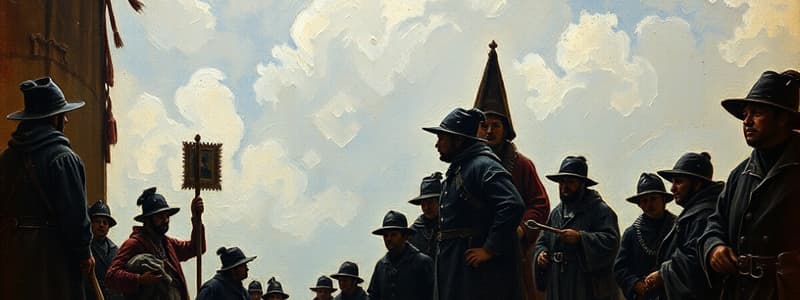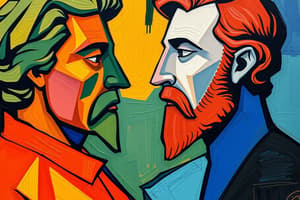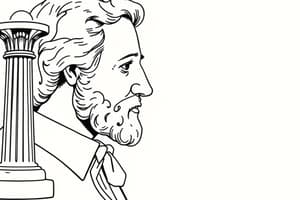Podcast
Questions and Answers
What was a primary aim of labour unions during the Industrial Revolution?
What was a primary aim of labour unions during the Industrial Revolution?
- To secure good wages for workers (correct)
- To promote child labour
- To eliminate workplace safety regulations
- To reduce the number of workers in factories
Which of the following best describes the belief of feminism during the Industrial Revolution?
Which of the following best describes the belief of feminism during the Industrial Revolution?
- Women are inherently inferior to men
- Women and men should be treated equally in all respects (correct)
- Men and women should be treated unequally
- Women should not work alongside men
What was one consequence of unions demanding higher wages for workers?
What was one consequence of unions demanding higher wages for workers?
- Lower prices for consumer goods
- Greater support for child labour practices
- Decrease in total employment
- Increase in the price of goods (correct)
What significant legal right was granted to women in Canada in 1918?
What significant legal right was granted to women in Canada in 1918?
What does universal suffrage entail?
What does universal suffrage entail?
What were the conditions faced by workers during the Industrial Revolution described in classical liberalism?
What were the conditions faced by workers during the Industrial Revolution described in classical liberalism?
Who were the Luddites, and what did they stand for?
Who were the Luddites, and what did they stand for?
What was the main goal of the labour movements and unions that emerged from the conditions of classical liberalism?
What was the main goal of the labour movements and unions that emerged from the conditions of classical liberalism?
What was the People’s Charter of 1838 aimed at achieving?
What was the People’s Charter of 1838 aimed at achieving?
What was a major consequence of the Industrial Revolution related to child labor?
What was a major consequence of the Industrial Revolution related to child labor?
What did the International Labour Organization, formed in 1919, aim to address?
What did the International Labour Organization, formed in 1919, aim to address?
What was a common sentiment towards entrepreneurs during the time of classical liberalism?
What was a common sentiment towards entrepreneurs during the time of classical liberalism?
What was the main purpose of the Factory Acts passed in the late 1800s and early 1900s?
What was the main purpose of the Factory Acts passed in the late 1800s and early 1900s?
Flashcards
Feminism
Feminism
A movement advocating for equal rights and opportunities for women, challenging traditional gender roles and discrimination.
Labor Unions
Labor Unions
Organizations formed by workers to collectively bargain for better wages, working conditions, and protection against exploitation.
Voting Rights
Voting Rights
The right of all adult citizens to participate in political decisions by casting a vote.
Liberalism
Liberalism
Signup and view all the flashcards
Suffragists
Suffragists
Signup and view all the flashcards
Industrial Revolution
Industrial Revolution
Signup and view all the flashcards
Classical Liberalism
Classical Liberalism
Signup and view all the flashcards
Entrepreneurs
Entrepreneurs
Signup and view all the flashcards
Luddites
Luddites
Signup and view all the flashcards
Chartism
Chartism
Signup and view all the flashcards
Factory Acts
Factory Acts
Signup and view all the flashcards
International Labour Organization (ILO)
International Labour Organization (ILO)
Signup and view all the flashcards
Study Notes
Classical Liberalism's Consequences
- The Industrial Revolution created stark wealth inequality (disparity), child labor, worker abuse, and environmental damage.
- Individuals could invest and profit, but many workers faced unsafe conditions for low pay.
- "Robber barons" exploited workers, creating social unrest and contributing to issues like pollution and slums.
- Technological advancements led to worker displacement and protests, exemplified by the Luddites.
Labour Movements and Unions
- Harsh working conditions spurred the formation of labor movements and unions.
- Workers sought to have their own voice and interests represented, challenging the idea of universal opportunity.
- Unions gained influence, culminating in the creation of the International Labour Organization (ILO) in 1919.
- Unions played a role in worker protection, strikes, and potentially higher prices of goods by demanding increased wages.
Chartism
- Chartism was a significant worker movement (1838-1857) demanding greater political involvement.
- The People's Charter of 1838 advocated for universal male suffrage, secret ballots, equal electoral districts, and annual elections (no fixed terms for MPs).
- The Chartist movement encountered resistance from Parliament and did not achieve its goals until later reforms, focusing on electoral reform.
Factory Acts and Worker Protection
- Factory Acts in the late 1800s and early 1900s improved worker conditions, especially for women and children.
- These laws focused on workplace safety and limitations on working hours for younger employees.
- The laws are seen as a progressive step aligned with liberal principles promoting workers' rights.
Feminism
- The Industrial Revolution saw women working alongside men, but gender inequality persisted.
- Suffragists advocated for women's rights, including the right to vote.
- Modern feminism continues to fight for gender equality.
Voting Rights - Universal Suffrage
- Liberalism promotes the idea that all citizens should equally participate and have a vote.
- Universal Suffrage, where every adult has the right to vote, is a key concept of liberalism.
- Canada granted women the vote in 1918; Aboriginal peoples followed in 1960.
Studying That Suits You
Use AI to generate personalized quizzes and flashcards to suit your learning preferences.




